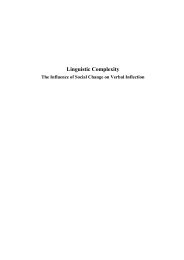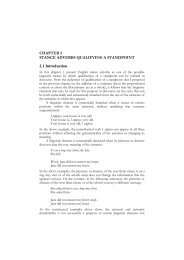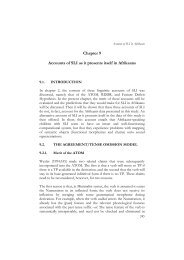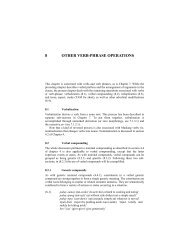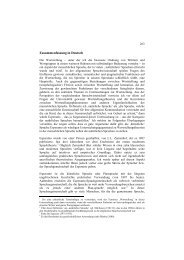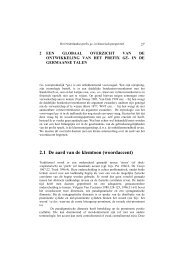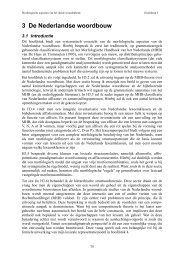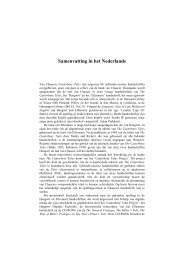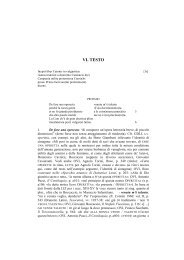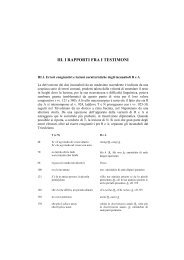Linking elements in compounds - LOT publications
Linking elements in compounds - LOT publications
Linking elements in compounds - LOT publications
Create successful ePaper yourself
Turn your PDF publications into a flip-book with our unique Google optimized e-Paper software.
Table 4<br />
SIMILARITY OF PLURAL ENDINGS AND LINKING ELEMENTS<br />
Mean Rat<strong>in</strong>g Scores with Standard Deviations (between brackets) along a Five-po<strong>in</strong>t Scale<br />
for n-Realization (1, 2 = [ə]; 3 = unclear; 4, 5 = [(ə)n]) per Condition (Phrase or<br />
Compound) and Region (North, East, South, Middle or West)<br />
Condition Region<br />
North East South Middle West<br />
Phrase 4.12 (1.50) 3.58 (1.74) 3.11 (1.92) 2.63 (1.81) 2.25 (1.76)<br />
Compound 3.59 (1.81) 3.17 (1.90) 3.00 (1.92) 2.16 (1.72) 1.83 (1.58)<br />
Analyses us<strong>in</strong>g a l<strong>in</strong>ear mixed-effects model with subject and item as crossed<br />
random effects, the rat<strong>in</strong>g score as dependent variable and Condition and<br />
Region as predictors revealed a significant ma<strong>in</strong> effect of Condition (β = 0.45,<br />
t(3242) = 3.12, p < .01). This <strong>in</strong>dicates that phrases showed significantly higher<br />
n-realization scores than <strong>compounds</strong>. Furthermore, a marg<strong>in</strong>al <strong>in</strong>teraction<br />
between Condition and Region South was found (β = 0.34, t(3242) = 1.91, p =<br />
.06), <strong>in</strong>dicat<strong>in</strong>g that the Southern region showed no significant differences for<br />
n-realization <strong>in</strong> phrases versus <strong>compounds</strong>. These results similarly show the<br />
speakers from the Northern, Eastern, Middle, and Western regions of the<br />
Netherlands to display greater f<strong>in</strong>al -n realization <strong>in</strong> plural nouns than <strong>in</strong> the<br />
first part of a compound. 7<br />
7 A l<strong>in</strong>ear mixed-effects model for b<strong>in</strong>om<strong>in</strong>al data reveals the same results. Here, only<br />
the ―no [n]‖ responses (i.e., scores 1 and 2) and ―[n]‖ responses (i.e., scores 4 and 5)<br />
were considered and the 3 scores (1.8%) were excluded. Analyses us<strong>in</strong>g a l<strong>in</strong>ear mixedeffects<br />
model with a logit l<strong>in</strong>k function, with subject and word as crossed random<br />
effects, Condition and Region as <strong>in</strong>dependent variables, and the [n]-realization scores as<br />
the dependent variable revealed a significant ma<strong>in</strong> effect of Condition (β = 0.55,<br />
z(3186) = 2.83, p < .01) and a marg<strong>in</strong>al <strong>in</strong>teraction between Condition and Region<br />
South (β = 0.43, t(3178) = 1.78, p < .1).<br />
43



